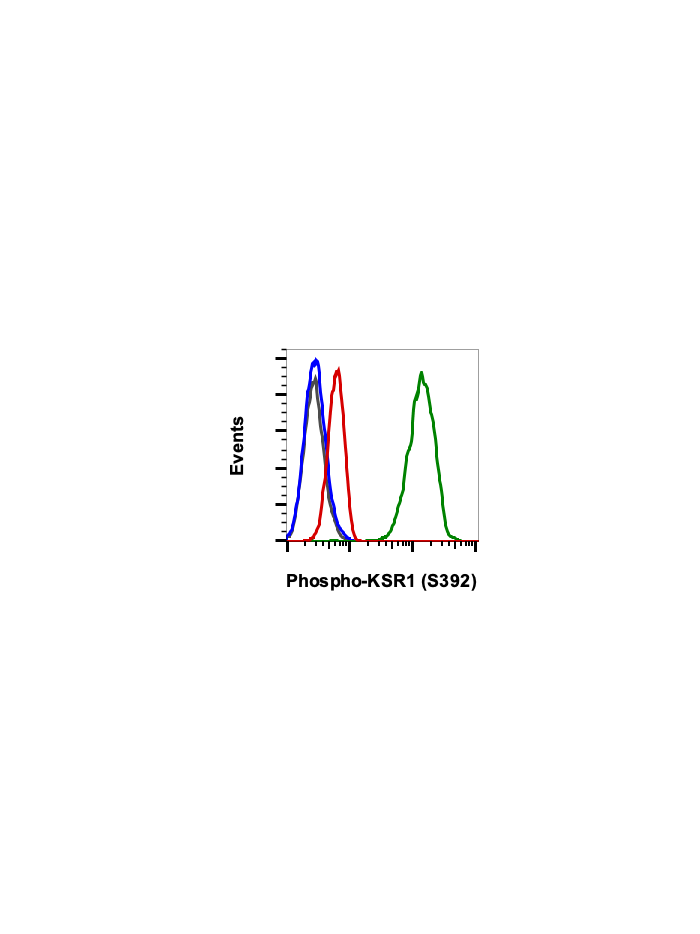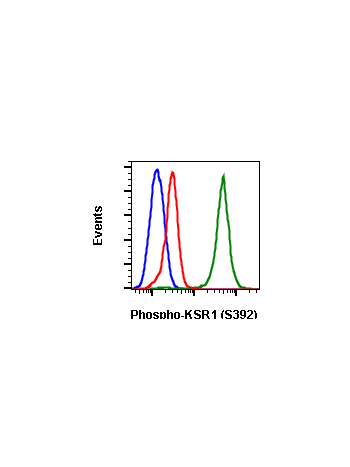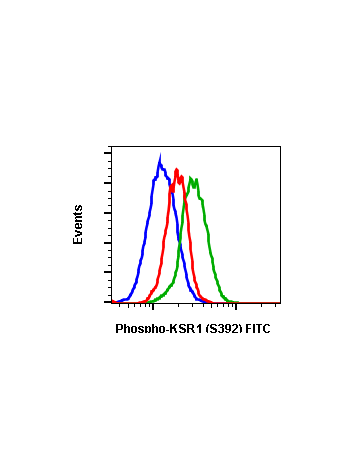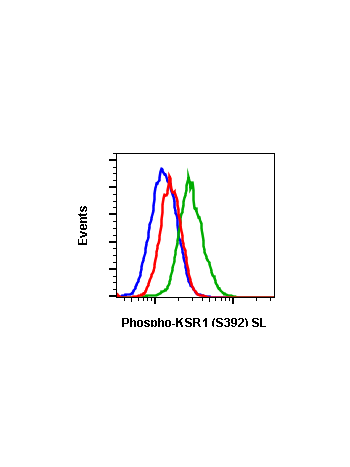Phospho-KSR1 (Ser392) (3A4) rabbit mAb PE conjugate
The kinase suppressor of Ras 1 (KSR1) is a molecular scaffold protein that regulates the activation of the Raf/MEK/extracellular signal-regulated kinase (ERK) signal transduction pathway (1-3). KSR1 expression regulates the intensity and duration of growth factor-induced ERK activation to modulate cell proliferation, H-RasV12-induced transformation and senescence, and adipogenic potential. KSR1 disruption in mammalian models inhibits oncogenic Ras-induced senescence and transformation in vitro and in vivo (4,5). KSR1 translocates to the plasma membrane in response to growth factor treatment and Ras activation, where it forms a complex involving Raf-1, MEK1 and 14-3-3 protein and facilitates the activation of MEK by Raf and of ERK by MEK (6). KSR1 also mediates ERK-dependent negative feedback signaling on Raf, MEK, and KSR1 (7). In non-stimulated cells, KSR1 is sequestered in the cytosol through 14-3-3 protein binding after phosphorylation by C-TAK1 at Ser297 and Ser392. Meanwhile, KSR1 constitutively interacts with MEK and ERK. Upon growth factor stimulation, activated Ras triggers the dephosphorylation of KSR1 at Ser392 by PP2A, leading to the release of 14-3-3 protein from its binding sites. This in turn allows phospho KSR1 to translocate to the cell membrane, where phospho KSR1 forms a complex with Raf, MEK and ERK (8). KSR1 thus potentially enhances the phosphorylation of Raf, MEK and ERK, facilitating the upstream signalling transduction as well as regulating multiple cellular functions by activation of various substrates.
| Applications | Flow Cytometry |
|---|---|
| Clone | KSR1S392-3A4 |
| Format | PE |
| Validated Reactivity | Human, Mouse |
| Cross Reactivity | Predicted to work with mouse, rat and other homologues. |
| Clonality | Monoclonal |
| Immunogen | A synthetic phosphor-peptide corresponding to residues surrounding Ser392 of human phospho KSR1 |
| Formulation | 1X PBS, 0.09% NaN3, 0.2% BSA |
| Isotype | Rabbit IgGk |
| Preparation | Protein A+G |
| Recommended Usage | For flow cytometric staining, the suggested use of this reagent is 5 µL per million cells or 5 µL per 100 µL of staining volume. It is recommended that the reagent be titrated for optimal performance for each application. |
| Storage | 2-8ºC |
| Pseudonyms | Kinase suppressor of Ras 1 |
| Uniprot ID | Q8IVT5 |
| References | 1. Kortum RL, et al., (2004) Mol. Cell. Biol. 24:4407–16. 2. Nguyen A, et al., (2002) Mol. Cell. Biol. 22:3035–45. 3. Roy F, et al., (2002) Genes Dev. 16:427–38. 4. Kortum RL, (2006) Cell. Biol. 26:2202–14. 5. Lozano J, et al., (2003) Cancer Res. 63:4232–8. 6. Sundaram M, et al., (1995) Cell 83:889–901. 7. McKay MM, et al., (2009) Proc. Natl. Acad. Sci. U. S. A. 106:11022–7. 8. Therrien, M, et al., (1995) Cell 83, 879–88. |




